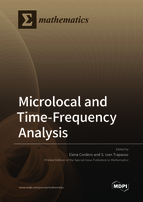Microlocal and Time-Frequency Analysis
A special issue of Mathematics (ISSN 2227-7390).
Deadline for manuscript submissions: closed (31 October 2021) | Viewed by 14619
Special Issue Editors
Interests: time-frequency analysis; harmonic analysis; evolution equations; Gabor matrix representations of operators; modulation and Wiener amalgam spaces; signal analysis
Interests: time-frequency analysis, microlocal and semiclassical analysis; applications to mathematical physics and partial differential equations
Special Issue Information
Dear Colleagues,
The focus of this Special Issue of Mathematics lies in two fascinating areas of modern mathematics with a broad spectrum of applications ranging from theoretical physics to signal processing, namely, microlocal and time-frequency analysis. The fruitful interaction between the two disciplines is witnessed by the vast body of literature published in recent decades. It is worth mentioning the following problems among several ones which have benefited from this joint perspective, without any claim of being exhaustive: properties of quantization rules, pseudodifferential and Fourier integral operators; algebras of sparse operators in phase space; well-posedness of nonlinear dispersive PDEs and representation of their solutions; wave front sets and propagation of singularities.
In order to further explore these research trends, we solicit original, high-quality papers on microlocal and time-frequency analysis and their applications. Contributions on related topics, including for instance mathematical signal processing, harmonic analysis, and mathematical physics are welcome as well, provided that they mainly focus on aspects of or connections with microlocal and Gabor analysis. We also invite expository and review papers by senior researchers aimed at elucidating finer points or highlighting techniques of broad interest.
The contributions may be submitted on a continuous basis before the deadline and will be selected, after a peer-review process by leading experts, in view of both their quality and relevance.
Prof. Dr. Elena Cordero
Dr. S. Ivan Trapasso
Guest Editors
Manuscript Submission Information
Manuscripts should be submitted online at www.mdpi.com by registering and logging in to this website. Once you are registered, click here to go to the submission form. Manuscripts can be submitted until the deadline. All submissions that pass pre-check are peer-reviewed. Accepted papers will be published continuously in the journal (as soon as accepted) and will be listed together on the special issue website. Research articles, review articles as well as short communications are invited. For planned papers, a title and short abstract (about 100 words) can be sent to the Editorial Office for announcement on this website.
Submitted manuscripts should not have been published previously, nor be under consideration for publication elsewhere (except conference proceedings papers). All manuscripts are thoroughly refereed through a single-blind peer-review process. A guide for authors and other relevant information for submission of manuscripts is available on the Instructions for Authors page. Mathematics is an international peer-reviewed open access semimonthly journal published by MDPI.
Please visit the Instructions for Authors page before submitting a manuscript. The Article Processing Charge (APC) for publication in this open access journal is 2600 CHF (Swiss Francs). Submitted papers should be well formatted and use good English. Authors may use MDPI's English editing service prior to publication or during author revisions.
Keywords
- Microlocal analysis
- Time-frequency analysis
- Harmonic analysis
- Partial differential equations
- Pseudodifferential and Fourier integral operators
- Localization operators
- Symplectic methods in harmonic analysis
- Propagation of singularities
- Semiclassical analysis
- Function spaces of harmonic analysis
- Frames
- Wavelets
- Group theory
- Wave front sets
- Signal analysis
- Reproducing formulae
Benefits of Publishing in a Special Issue
- Ease of navigation: Grouping papers by topic helps scholars navigate broad scope journals more efficiently.
- Greater discoverability: Special Issues support the reach and impact of scientific research. Articles in Special Issues are more discoverable and cited more frequently.
- Expansion of research network: Special Issues facilitate connections among authors, fostering scientific collaborations.
- External promotion: Articles in Special Issues are often promoted through the journal's social media, increasing their visibility.
- e-Book format: Special Issues with more than 10 articles can be published as dedicated e-books, ensuring wide and rapid dissemination.
Further information on MDPI's Special Issue polices can be found here.






